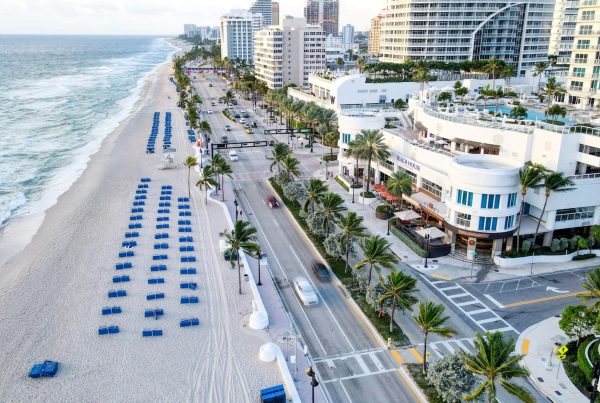After a six-week break because of the summer schedule, the Boca Raton City Council meets Monday and Tuesday. The council will be busy.
Though it isn’t listed on the agenda for Monday’s workshop meeting, I’m told that Brightline Virgin Trains representatives may be there to discuss a station for Boca Raton. There have been rumors for weeks about the company wanting to add stations beyond the three in West Palm Beach, Fort Lauderdale and Miami.
The site would be land between the downtown library and the Florida East Coast Railway tracks that Brightline uses. The city previously had considered the land for a station along a coastal version of Tri-Rail, the commuter service that operates on the western CSX tracks.
Any Brightline station, however, would be much more than just a station. All three existing stations have been real estate plays, with surrounding development. The Miami station is part of a $3 billion project.
Would Brightline ask the city to donate the land? Would the company ask for other concessions? The site is adjacent to the boundary of the community redevelopment agency and thus is not subject to rules that cap the cumulative amount of downtown development.
The “transit discussion” item on Monday’s agenda concerns a downtown system, not Brightline. If the company shows, I’ll have an update next week.
Boca National on the agenda; Gumbo Limbo update

Also at that Monday workshop, there will be more discussion of the proposed Boca National golf course.
Before we get to that topic, however, here’s an update on Gumbo Limbo Nature Center. The topic is not that far off point. Gumbo Limbo has come up indirectly during the debate over a new municipal golf course.
According to a city spokeswoman, the second and final phase of Gumbo Limbo’s boardwalk replacement is complete. The new section is not open, however, because the city—which is managing the project—hasn’t completed its punch list with the contractor. There is no date for when the new phase will open.
There’s also uncertainty about the new tower, which would replace the four-story structure that was torn after successive batterings by hurricanes. Many Boca Raton residents—such as I—remember hiking up with their children and would like to take their grandchildren. This project, however, is complicated.
The old tower predated the Americans With Disabilities Act. The new one would have to comply with the law. That would mean including a four-story elevator, which could cost between $500,000 and $600,000. The tower would cost $180,000.
As with the boardwalk, the Greater Boca Raton Beach and Park District would finance the project and the city would manage it. The Friends of Gumbo Limbo are helping with fundraising.
On Tuesday’s city council agenda is an item to authorize the naming of the tower for a 2016 graduate of Boca Raton High School and student at Vanderbilt University who was killed last year in a traffic accident in Utah. According to the staff report, the family is donating $250,000, with the Friends of Gumbo Limbo working to raise the rest. The city owns all of Red Reef Park, even though the district pays for the operations and maintenance. According to a city spokeswoman, the naming thus requires approval by the city.

Gumbo Limbo has come up during the Boca National discussion because of the center’s master plan for the nature portion and the many exhibits. One estimate placed the cost at $30 million.
In March, Compson Associates met with council members and district commissioners to discuss the company’s idea for a Ritz Carlton hotel and marina on Ocean Strand. Company representatives said they would buy the 15 acres of Ocean Strand from the district for $45 million, which would cover construction of Boca National and the Gumbo Limbo master plan.
The scenario seems unlikely, given the elected officials’ reactions. Still, it did cause everyone to acknowledge that the district can’t pay for a massive Gumbo Limbo makeover.
As for the city, the spokeswoman said the master plan may have become caught up in the wider waterfront park plan that a consultant developed. The last major change at Gumbo Limbo was the new pavilions and sea tanks in 2012. The district financed that project.
There probably needs to be more communication about Gumbo Limbo between the city and the district. But communication is the ongoing problem.
Which brings us to Boca National.
When we left this topic in early June, the beach and park district had proposed that the city finance construction of the course—which will be at least $20 million but could be as much as $28 million—but adhere to the district’s plan and let the district decide how to operate the course. The city council didn’t go along, in part because the members collectively didn’t like the design.
According to a memo from Deputy City Manager George Brown, the district now proposes to pay any construction costs above $20 million and all fees to the design firm of Price Fazio. The tunnel between the west side of the course and the east has been eliminated, and the district no longer will ask the city to abandon a portion of Jeffrey Road on the east side of the property. The city would like to connect Federal Highway with Clint Moore Road. Abandonment would prevent that.
The district also proposes that both sides would have to agree on any “major changes” to the design. The district and city would share operating profits and losses—55 percent for the district and 45 percent for the city. Once both sides had recouped their investment, the district would assume full control of operations and be responsible for any surpluses or deficits.
That may sound like progress, but Brown’s memo also details information that the city still wants to get from the district. The city still may engage a consultant to advise on the feasibility of a course like the district has proposed.
And Councilman Andy Thomson still wants his colleagues to hear from officials in Winter Park, the Orlando suburb that has a municipal course far different from what the district proposes. Thomson hoped that those representatives could appear at Monday’s workshop, but they can’t get here until the Aug. 26 workshop meeting.
Complicating matters is that the district must set its property tax rate in September. That will be difficult, given the uncertainty over whether the city will contribute that $20 million. Heading into the Monday meeting, Boca National remains a mess.
Sustainability gets serious in Boca

Delray Beach has emphasized sustainability and resiliency for years. Now Boca Raton wants to get serious.
Again at that Monday workshop, Sustainability Manager Lindsey Nieratka will lay out the staff’s 49-page proposal that covers everything from energy conservation to composting. Among other things, the report notes that per capita water consumption in the city is down 26 percent since 2005, even as population is up 20,000.
Boca Raton is part of the Southeast Florida Regional Climate Compact, but the city’s participation has been middling. Perhaps that’s because Delray Beach has a more immediate problem with tidal flooding. Unlike Delray Beach, Boca Raton also chose not to ban single-use plastic straws but to discourage their use.
The report explains how Boca Raton can mitigate the effects of greenhouse gas emissions by expanding the tree canopy. There’s a mention of gas-powered leaf blowers, which almost all lawn services use.
According to the report, the city has accomplished 10 percent of the goals within it. Monday begins talk on how to accomplish the other 90 percent.
Tri-Rail abandons second Boca station

Tri-Rail has abandoned the idea of a second station in Boca Raton. There’s another setback because of city council politics regarding Midtown.
Four years ago, major Midtown landowners—led by Crocker Partners—envisioned a coordinated redevelopment of Midtown, the area east of Town Center Mall. One feature would have been a Tri-Rail station to serve the area, which is an employment hub like the area served by the station on Yamato Road.
But the BocaWatch website used scare tactics to discourage the idea of allowing residential development, which rules now prohibit. Even though the city designated Midtown for housing, Councilwoman Andrea O’Rourke led the charge against the landowners’ plan.
In January 2018, the council went along, refusing to approve redevelopment rules and asking staff to create a “small area plan.” Crocker sued, the other landowners went their own way and the grand plan fell apart. According to Tri-Rail Executive Director Steven Abrams, the Tri-Rail money that would have gone to Boca Raton will go toward the agency’s Northern Layover facility.
Ironically, the rabid Midtown opponents cited traffic as an issue. Yet the Tri-Rail station would have been one way to reduce traffic. But the Midtown fight was never about logic. It was about politics.







